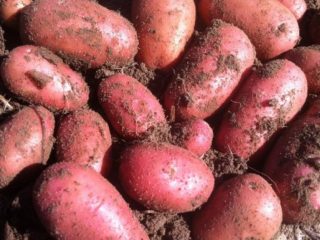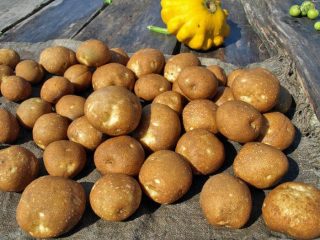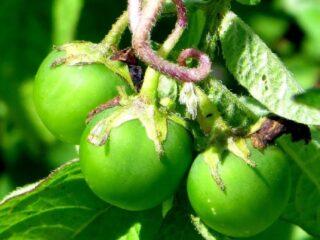Content
Mid-season varieties are popular in the northern regions of the country. Felox potatoes have recently become known to Russian gardeners and have gained well-deserved popularity. The variety is promising for further cultivation in home gardens.

Tubers reach technical maturity in 70-75 days
History of selection
The Felox potato variety was bred by German breeders from the originator “Saka Palanzenzucht”. In Russia, the subspecies is distributed by the Oktyabrsky enterprise and the Sedek farm. It tolerates drought and sudden temperature changes well, so it is suitable for growing in any region.
The variety was included in the State Register of the Russian Federation for the Middle Volga region in 1999.
Description of Felox potato variety
The plant is erect, the leaves are green to dark in color. The variety has a multi-purpose table purpose. Felox is popular in home cooking for preparing second and first courses. Pairs with vegetables, fish and meat.
Bush
High-yielding potato variety Felox. The erect plant has medium to large, glossy, dark emerald, jagged leaves. The corolla is large, lilac in color.

Anthocyanins in the variety are weakly expressed
Tubers
Potatoes have elongated fruits with a yellow skin and a light core. The pulp is snow-white-amber in color. High yield. Tubers reach from 100-120 g to 200 g in weight. Collect 15-25 tubers from a bush.
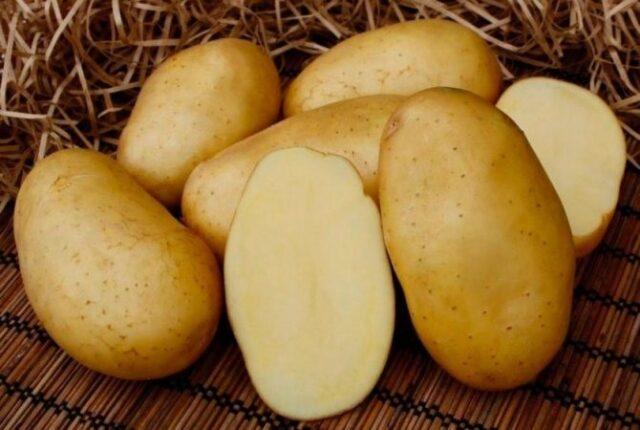
The starch content in Felox potatoes is 16-17%
Characteristics of Felox potatoes
The variety is unpretentious to growing conditions, therefore it is very popular in the North-Western, Northern and Middle Volga regions. Felox potatoes are resistant to diseases and pests. It has good keeping quality up to 90% and a yield of 550-600 centners per 1 ha.
Taste qualities of Felox potatoes
The mass of tubers reaches 120-200 g. Up to 25 pieces are collected from one bush. High taste qualities make root vegetables a universal table variety. The flesh does not darken when cut. Used in preparing first and second courses.
Ripening time
Mid-season ripening is 65-75 days from emergence. Attracts gardeners from northern regions with risky farming. Tubers are dug from August to November.
To determine the ripeness of the fruit, the bush is dug up from the end of July. Young potatoes are used in preparing main courses. Each region has its own harvest dates. In the south, tubers can be stored in the ground until November, and in the north - until September. It is important to harvest before the first frost.

To select seed potatoes, the tubers are left in rows and the healthiest specimens are selected
To preserve the harvest longer, the tubers are covered with wormwood hay, elderberry or rowan branches and placed in the basement. They sort through them once a month, the rotten fruits are thrown away, and those lying nearby are selected for cooking. Experts recommend ventilating the room to ensure high humidity and a constant temperature of +10 0WITH.
Productivity
Mid-season potatoes Felox are classified as productive varieties. 550-600 centners are collected from 1 hectare. Up to 25 tubers are formed on one bush. The variety is resistant to pests and diseases. In a basement with a constant temperature of +10 0With 90% humidity, the fruits last for six months.
Excellent commercial qualities ensure good transportation. The integrity of the product is 98%, which allows Felox potatoes to be transported to remote regions.
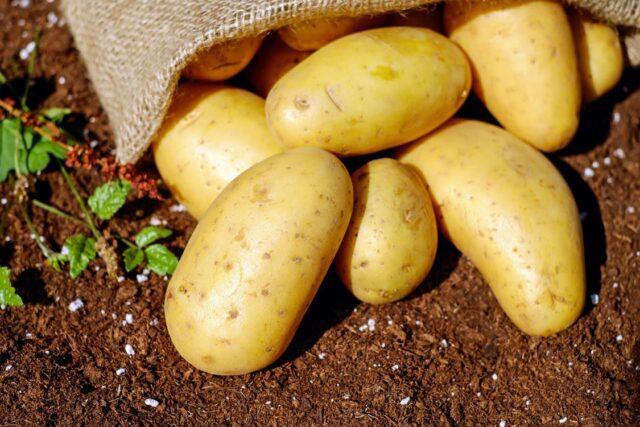
The minimum harvest from 1 hectare is 250 c
Growing regions
The Felox potato variety, developed by German breeders, quickly gained popularity in Germany, Austria and Holland. The crop is actively grown in India, China and Russia. The high yield of the variety makes it popular in the CIS countries. Felox potatoes are grown in Ukraine, Moldova, Kazakhstan and Belarus.
Disease resistance
Potatoes, like any vegetable crop, are susceptible to pests, despite their high protective functions.
The Felox variety is resistant to the following diseases:
- nematode;
- late blight;
- scab;
- Alternaria;
- fusarium;
- verticillium.
The variety is susceptible to wireworms and the Colorado potato beetle. Therefore, Felox potatoes are treated against pests with chemicals and folk remedies are used.
The larvae of all click beetles are called wireworms. The body reaches a length of 1-5 cm. They have a color from light yellow to brown. Experts note the effectiveness of the drug Prestige in the fight against wireworms and Colorado potato beetles. Its action is complemented by the application of insecticides and mulching with freshly cut grass.
Advantages and disadvantages
Felox potatoes belong to the mid-early ripening varieties. High resistance to temperature changes and drought allows the crop to be grown in different regions. The Felox variety planted in May produces a harvest in August.

Proper storage ensures the shelf life of Felox potatoes until mid-spring
Pros:
- unpretentiousness to temperature changes, drought resistance;
- grows in various soils;
- high taste indicators;
- shelf life, storage during transportation over long distances;
- resistance to diseases and pests;
- early ripening variety;
- high yields subject to agricultural technology;
- nematode resistance.
Minuses:
- suffers from wireworms and Colorado potato beetles;
- subject to scab;
- In wet soil, the tuber may rot.
Landing Features
Agricultural technology is standard, as the variety is resistant to drought and temperature changes. Planting in most regions takes place in May-June. Harvesting continues from August to November. Experts advise observing crop rotation. It is best to plant potatoes after peas, corn or beans.
It is recommended to plant tubers according to a 30*65 cm pattern to a depth of 8 cm. Felox does not like humidity, therefore it is not recommended for planting in regions with high groundwater levels.
The land is prepared in the fall. Phosphorus-potassium fertilizers and lime are applied to reduce the pest population.Potatoes love slightly acidic soil. Before planting, the tubers are sorted out. The damaged ones are thrown back. Choose medium seed weighing up to 100 g.
It is recommended to dig up the loam with the addition of humus and sand. In hard soil, the tubers become deformed and produce little fruit. Before planting, the holes are treated with a weak solution of potassium permanganate or Fitosporin.
Care instructions
Felox potatoes are planted in loose, moist soil. Maintain a distance between plants of 30 cm and between rows of 60 cm. To speed up the growth of tops, granular fertilizer is added when planting.
During long periods of drought, Felox potatoes are watered to increase yield. Well-formed green mass allows you to get large tubers. A healthy plant has protective properties and is not susceptible to pests and diseases.
Frequent watering is necessary during the period of growth of green mass, budding and formation of tubers of the crop. Potatoes are fertilized 2-3 times per season. Nitrogen and potassium fertilizers are used.
An infusion of chicken manure or herbs is diluted with water and watered to increase green mass in the first trimester. During the flowering period of the Felox potato, an infusion of ash is made. Potassium fertilizer increases productivity.
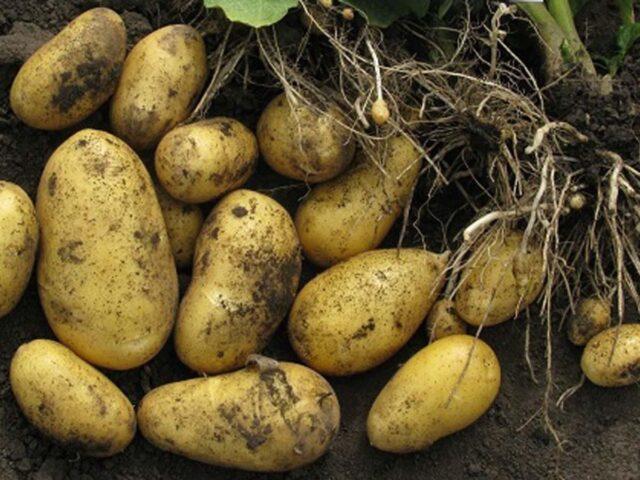
Fertilizers are applied to moist soil after rain or watering in cloudy weather.
In order for the plant to grow healthy, the soil is loosened and the bushes are weeded to remove weeds. Hilling is carried out as the height increases, once every two weeks, no more than 2-3.
Harvest and storage
Felox potatoes are mid-season varieties.In the southern regions, young tubers are dug up as early as June, provided they are planted early in the ground. In northern latitudes, harvesting begins in early August. If the requirements of agricultural technology are observed, timely treatment against pests and fertilizing, a rich harvest is harvested.
Long-term storage of potatoes is achieved in the basement at a constant temperature of +10 0C and humidity 90%. Tubers are placed in boxes with holes for ventilation. To prevent mice from gnawing on the potatoes, the storage area is lined with branches of elderberry, rowan and wormwood. To ensure air access, boxes or bags are placed on boards. Leave a distance of 2-3 cm to the floor. Ventilate the room periodically. Tubers are sorted once a month. Rotten specimens are thrown away so as not to infect neighboring ones.
Conclusion
Felox potatoes have high taste qualities, therefore they are widely used in table production. Resistance to sudden temperature changes and early ripening make the variety popular in the northern regions of the country. By observing agrotechnical requirements, a high yield is obtained.


